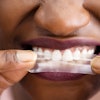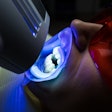Red wine is a bigger culprit than coffee when it comes to stains following teeth-whitening treatments, according to a new study in Acta Odontologica Scandinavica (February 19, 2013).
A team of researchers in clinical practice in São Paulo, Brazil, evaluated the influence of coffee and red wine staining on tooth color during and after bleaching.
They divided blocks obtained from human molars into 11 groups (n = 5) in accordance with the bleaching treatment (peroxide carbamide 10%, 15%, or 20%) and with the staining ingredient (coffee, wine, or control). Color change analysis was assessed using a spectrophotometer, during and after the bleaching treatment at several intervals.
The researchers found that the concentrations of carbamide peroxide did not differ significantly from the control group during bleaching up to the 22nd day. However, after bleaching, they found statistically significant differences between the groups treated with coffee (30th day) and wine (7th and 30th days) relative to the control, which was treated with whitening agents.
"During bleaching, remineralization of the enamel with artificial saliva and the subsequent bleaching session were effective in preventing enamel staining," the study authors reported. "After the whitening procedures, both stain therapies -- coffee and wine -- caused enamel color changes; however, the wine led to greater staining than did coffee."



















